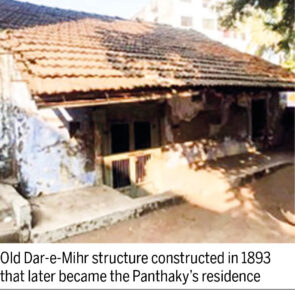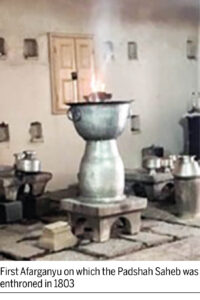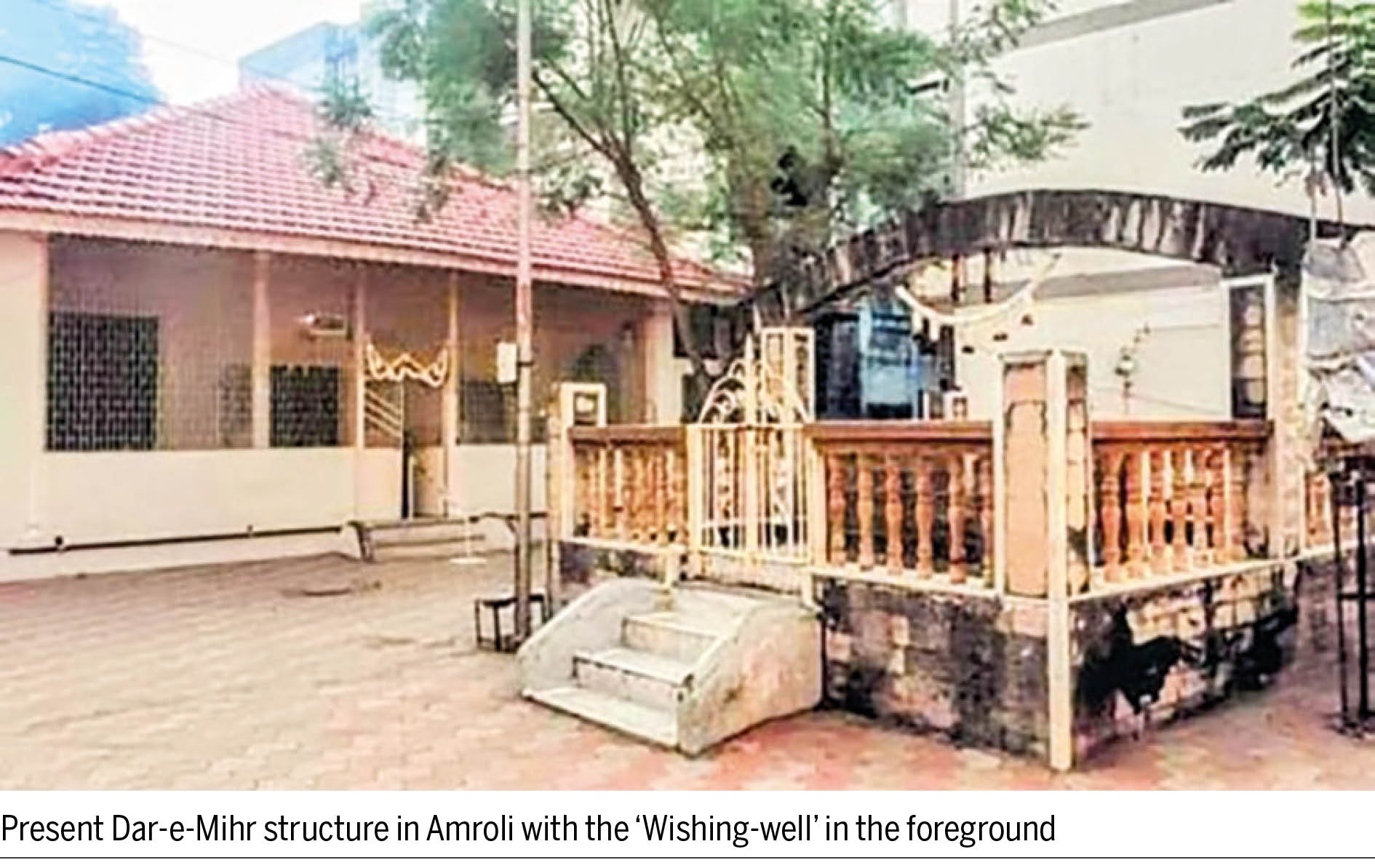Adil J. Govadia
 Recently, in mid-January 2025, my wife and I visited a 222-year-old Adarian Saheb in Amroli village, situated 12 kms from Surat railway station. The antiquated structure is extremely simple, devoid of outward trappings of a typical Dar-e-Mehr, almost passing as a private residential bungalow. The access to the Dar-e-Mehr is through a simple metallic mesh door leading into a small prayer hall with old portraits hanging from the walls. After padyab-kushti and lighting divas in the small outer hall, we entered the inner Baj-Afringan room within, located in a tiny kebla (sanctum sanctorum) that houses the brilliantly luminous Adarian Saheb enthroned on a relatively large afarghanu (censor), that barely leaves enough space for two Mobeds to enter the Kebla.
Recently, in mid-January 2025, my wife and I visited a 222-year-old Adarian Saheb in Amroli village, situated 12 kms from Surat railway station. The antiquated structure is extremely simple, devoid of outward trappings of a typical Dar-e-Mehr, almost passing as a private residential bungalow. The access to the Dar-e-Mehr is through a simple metallic mesh door leading into a small prayer hall with old portraits hanging from the walls. After padyab-kushti and lighting divas in the small outer hall, we entered the inner Baj-Afringan room within, located in a tiny kebla (sanctum sanctorum) that houses the brilliantly luminous Adarian Saheb enthroned on a relatively large afarghanu (censor), that barely leaves enough space for two Mobeds to enter the Kebla.
The simplicity of the Agiary structure coupled with the disproportionate size of a rather large afarghanyu placed in an unusually tiny kebla projected a divinely imposing presence of powerful energies in this rustic but quaint Amroli Agiary. Indeed, we felt truly blessed that we visited this remarkable ancient spiritual storehouse! Stepping onto the antiquated stone-flooring that has absorbed the manthravani-vibrations for several decades was spiritually uplifting and an extremely emotional experience.
However, this spiritually thriving divine energy storehouse in Amroli was devoid of Zoroastrian footfalls. Though the lustre of this Adarian Saheb has silently guided the entire Parsi community in the Godavara region for over two centuries, the Dar-e-Mehr seemed deserted. Reduced footfalls directly impact income too, resulting in serious maintenance issues of these primeval religious structures, which, over time, get exposed to disuse, neglect and eventual encroachment.
It would be wonderful if Parsi visitors thronging popular Atash Behrams and Agiaries in Gujarat, also pay homage at least one of the several ancient village Dar-e-Mehrs dotting the outskirts of major cities like Bharuch, Surat and Navsari, so as to experience first-hand the deific energies prevailing there and also assist the clergy and local Anjumans with some income or donations.
In the front courtyard of the Amroli Dar-e-Mehr exists a ‘wishing-well’, famous for granting wishes of visiting devotees! According to Parsi Prakash Vol I, Seth Hormasjee Bomanjee Wadia, a celebrated, prosperous and affluent businessman of the early 19th century and trading-partner of the Scottish firm, Forbes & Co, first constructed a Dar-e-Mehr in Amroli on 24th November, 1803 in memory of his wife, Meherbai. Being rich and famous, he owned eight villages in Gujarat and was also the title-holder of the famed ‘Loveji Castle’, in erstwhile Bombay, built in 1793.
 Later, in 1837, his three sons – Seth Bomanjee ‘Bawa’ (the first native Indian to be appointed as the Commissioner of the Court of Requests), Seth Ardesar (co-founder of the Wadiaji Atash Behram in Mumbai) and Seth Rustomjee – co-financed a new Agiary, inaugurated on 30th October, 1837. Though there’s no specific takhti (tablet) available to specify its construction details, Er. Nanabhai Bhikaji, 19th century Panthaky from Godavra, reportedly helped in providing the basic particulars.
Later, in 1837, his three sons – Seth Bomanjee ‘Bawa’ (the first native Indian to be appointed as the Commissioner of the Court of Requests), Seth Ardesar (co-founder of the Wadiaji Atash Behram in Mumbai) and Seth Rustomjee – co-financed a new Agiary, inaugurated on 30th October, 1837. Though there’s no specific takhti (tablet) available to specify its construction details, Er. Nanabhai Bhikaji, 19th century Panthaky from Godavra, reportedly helped in providing the basic particulars.
Thereafter, on 2nd December, 1893, due to the dilapidated condition of the Dar-e-Mehr’s structure, Seth Kajnibhai Dorabji Mithaiwala constructed a new building for the Amroli’s Adarian Saheb (for Rs. 8000) which then came to be known as Seth Kanjibhai Dorabji Mithaiwala Adarian. On this auspicious day, over 700 Parsi Zoroastrians witnessed a unique ceremony of ijeshne after which twenty types of consecrated fires were put on four small censors and, after appropriate rituals, were enthroned on a bigger and newly obtained German silver censor, costing Rs 800, which is still in existence at the Dar-e-Mehr. The old censor from 1803 is however still in use for the Baj-edhora ceremonies!
Surat’s Dastur Noshirwanji and Dastur Rustomji, along with Mobed Behramji Hirjibhai Kundianewala performed the first Jashan ceremony in the new Agiary building, followed by a citation read out by Seth Edulji Rustomji Reporter before formally entrusting the Dar-e-Mehr to the Amroli Anjuman. The first Panthaky of the new Adarian was Er. Cawasji Dadabhoy Variava.
Bai Dinbai Nusserwanji Maneckji Petit magnanimously donated Rs 3000 in fixed deposits to finance the Agiary’s running cost from its interest, while Rs 1500 was collected from the members of the Anjuman. Seth Kanjibhai Mithaiwala donated an additional Rs. 3,500 towards the Maintenance Fund, in addition to paying a monthly subscription of Rs. 10/- towards its daily upkeep. Seth Kanjibhai also sponsored an underprivileged relative’s marriage at the new Dar-e-Mehr.
The current Panthaky, Er. Kaizad F. Mandiwiwala, is the third generation serving the Padshah Saheb with total dedication and gracious competence along with his charming wife, Parizad. Before him, his father (Er. Farokh Ardeshar Mandviwala) and grandfather (Er. Ardeshar Palanji Mandviwala) diligently served as Panthakys, since 1960.
